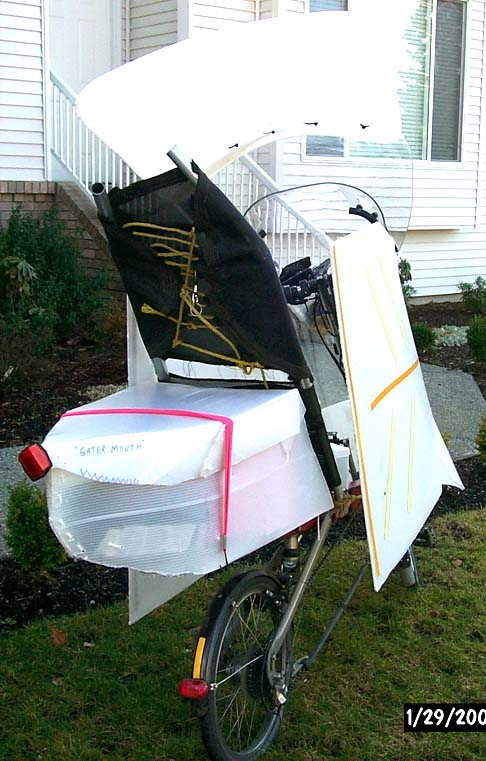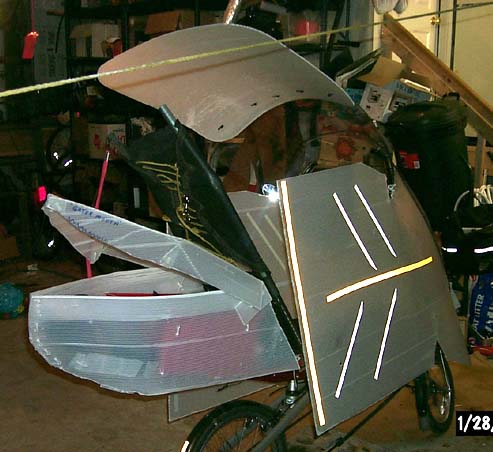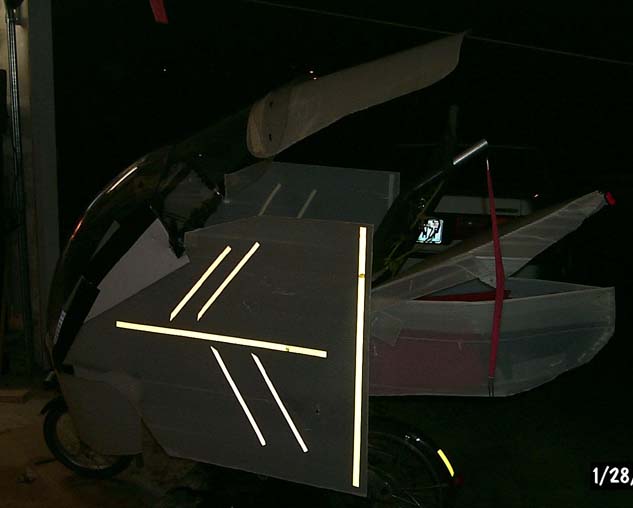I had a BikeE recumbent bike, in 1999:
In '99 I got a recumbent bike, called a BikeE, they were made in Oregon. I loved the bike, it was so easy and fun to ride. I used to ride to work 22 miles round trip everyday, but living in the rainy NW, I decided instead of getting wet all the time, I would make some modifications to my bike, which both made it faster, and helped keep me dry.
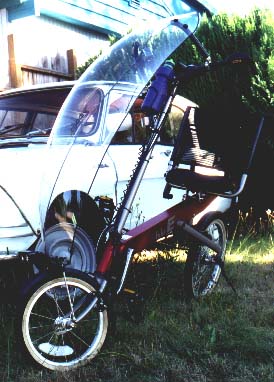
The BikeE came with a nice Zipper fairing.
|

BikeE sitting atop the Honda Accord '89. Notice the extension and the
front wheel supporting the fairing. The Zipper fairing did collapse on me at 65 MPH, so I use the front wheel to hold it in position. The wheel base is longer than the usual Yakima rack, or upright bikes.
|

This BikeE is equipped with radio, light switch, bell, cyclometer (Cateye solar), mirror, oh and a water bottle.
|

Using a spare handlebar extension mount, the Niterider headlight is mounted over the front wheel, using aluminum straps and zip ties. Mounted on the struts supporting the Zipper fairing.
|

I've got the batteries hidden inside the frame. See them sticking out just above the rear wheel (wrapped in duct tape). I have them out so that you can see them in this picture (normally they ride completely hidden inside the frame). The rear fender was attached to the frame. This didn't work when riding in the rain (It rains everyday in Seattle, pass it on), so I attached it to the rear fork. Also, I used a small piece of aluminum sheet metal to mount the rear tail light (no drilling, just slips right in).
|

The front fender wasn't stopping the bottom of my legs and the bottom of the frame from getting wet, so I extended the front fender to catch more water (gray piece of plastic conduit), and now it's working great. Keeps the bike cleaner too. Also I had to replace the original quick release lever, it broke from repeated use (within 2 months).
|
Next I added a roof:
![[Roof pic]](roofe1.jpg)
Picture of my roof in action! Notice my flipdown windshield (it flips up for
good weather).
Photo by John
Basically I don't like to get wet while riding. I know, I'm a wimp (but a creative one eh?).
So, I set out to build a roof. I used two pieces of 1 inch conduit, bent slightly in my
vise. I then purchased two "T" joints from the local hardware store (used for those conduit
buildings). Add some PCV piping (3/4 inch) along with a political sign (cheap coroplast) via some zip-ties, and there it's done.
I noticed that I was still getting wet from the front, so I added a piece of Lexan and duct
taped it to the front to become a flipdown windshield. Works like a charm. However, the
cost of protection from the rain has slowed me down a few MPH, but for me, that's a small
price to pay. Besides, I'm not racing anyway! And now, I don't need rain gear! That's a
big "plus" living in the rainy Seattle area. It might even work for those wanting to get out
of the intense heat, living "Down under" (using just the roof part, of course). I wouldn't
know about that though.
![[Picture of BikeE Roof]](roofe3.jpg)
|
![[BikeE roof]](roofe2.jpg)
|
Then I re-designed my roof system:
![[Roof pic]](side.jpg)
Well it all started when I was coming home against a strong head wind, one afternoon.
And was passed by a rider of an "normal" bike. Well, that was it. I had to redesign my roof.
I still wanted to keep dry in rainy weather (Liquid sunshine as we call it). So I purchased a piece of Lexan from the local hardware store (Home Depot), and fitted it atop of the Zzipper fairing. Effectively extending it to almost over my head.
The reason for this, was because I noticed that most of the liquid sunshine hits me from the front. The end result was a lighter/faster roof, that was equally successful at keeping the rain off.
Wouldn't you know it, but I get done with my new roof, and one morning a couple of weeks ago, I experienced a 50 mph tail wind. Now this was an interesting experience. I felt as though I was going up a ski lift on some of my ascents on my way to work.
An interesting development, the new design of the roof causes a vacuum just above my head. Thus sucking air up past my feet, and into the seating area (an updraft). This gets a little annoying when traveling above 30 mph.
Then I added side panels:
![[side pic]](sidepanels.jpg)
I've always wanted to have a fully enclosed bike. And this is as close as I've come so far. I used coroplast again, with a few trial and error adjustments here and there. The bulk of the weight is hanging on the handle bars. I cut a hole where the handle bar would go, and "fit" it over the handle bar. It's just taped to the rest of the front Zzipper fairing. However, I needed a third piece in the front that holds the front sections away from my feet (using zip ties).
It looks a little strange near my feet because on my first outing I was on my way to work, and I kept hitting the bottom edges with my pedals. So I stopped and cut out where my feet needed to go. Then when I got back home, I attached that front piece using zip ties. The stiffness of coroplast holds it away from my feet. If I was to do it over again, I would use the pattern that is now on the bike, and cut it from one 4x8 sheet of coroplast (with the center of the sheet being the center of the front). I've attached the rear of the panels to each other using surgical tubing (loosely, and one side is tied with a half bow after I get in). The panels being suspended by the handle bars and duct taped and zip tied to the steering move with the steering of the bike. All this does is limit how sharp of a U-turn I can make.
The only trouble I've had is traveling with 35 mph gusting cross winds. They forced me to stop about four times during my one hour commute home. When I say stop, I mean coming to a complete stop and bracing against the wind for a few minutes until the gusts died down. Otherwise I would end up being pushed over by the wind. Other than that, I've had numerous positive results. I've ridden in freezing weather and stayed warm without a coat. No more annoying "up drafts" due to the extended windshield. The rain, even heavy rain never touches me.
Final Modifications:

Added a roof, and a tailbox made with coroplast.
One time while ridding home, the rear fender detached and rotated under the rear wheel... this wasn't good, It effectively made the rear wheel skid and slide as if it was ice. And at 15 miles an hour my bike went down and I was sliding sideways, on the side panels, for quite a bit. I was shocked and surprised during this whole event, and then again surprised to find that despite the rather harsh crash and sliding on the concrete (on a bike path), that the side panels protected me from any damage, there wasn't a scratch on me. Normally, this type of crash with a bike causes all sorts of road rash, but not this time. I was just a little shaken up... So, I picked up my bike, and took off the offending fender and rode home...
Back to Dan's Skate Pages






![[Roof pic]](roofe1.jpg)
![[Picture of BikeE Roof]](roofe3.jpg)
![[BikeE roof]](roofe2.jpg)
![[Roof pic]](side.jpg)

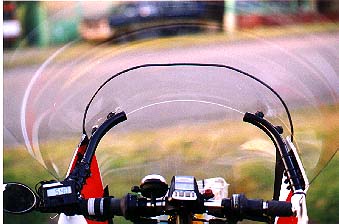
![[side pic]](sidepanels.jpg)

![[Picture of BikeE Roof]](bikee30.jpg)
![[BikeE roof]](bikee29.jpg)


